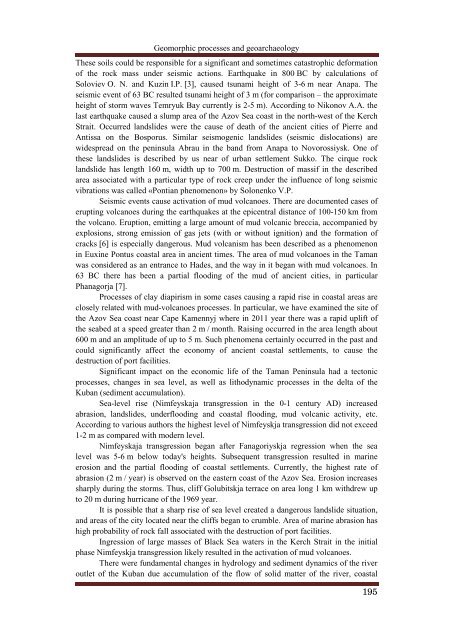extended abstracts - Geomorphic Processes and Geoarchaeology
extended abstracts - Geomorphic Processes and Geoarchaeology
extended abstracts - Geomorphic Processes and Geoarchaeology
You also want an ePaper? Increase the reach of your titles
YUMPU automatically turns print PDFs into web optimized ePapers that Google loves.
<strong>Geomorphic</strong> processes <strong>and</strong> geoarchaeology<br />
These soils could be responsible for a significant <strong>and</strong> sometimes catastrophic deformation<br />
of the rock mass under seismic actions. Earthquake in 800 BC by calculations of<br />
Soloviev O. N. <strong>and</strong> Kuzin I.P. [3], caused tsunami height of 3-6 m near Anapa. The<br />
seismic event of 63 BC resulted tsunami height of 3 m (for comparison – the approximate<br />
height of storm waves Temryuk Bay currently is 2-5 m). According to Nikonov A.A. the<br />
last earthquake caused a slump area of the Azov Sea coast in the north-west of the Kerch<br />
Strait. Occurred l<strong>and</strong>slides were the cause of death of the ancient cities of Pierre <strong>and</strong><br />
Antissa on the Bosporus. Similar seismogenic l<strong>and</strong>slides (seismic dislocations) are<br />
widespread on the peninsula Abrau in the b<strong>and</strong> from Anapa to Novorossiysk. One of<br />
these l<strong>and</strong>slides is described by us near of urban settlement Sukko. The cirque rock<br />
l<strong>and</strong>slide has length 160 m, width up to 700 m. Destruction of massif in the described<br />
area associated with a particular type of rock creep under the influence of long seismic<br />
vibrations was called «Pontian phenomenon» by Solonenko V.P.<br />
Seismic events cause activation of mud volcanoes. There are documented cases of<br />
erupting volcanoes during the earthquakes at the epicentral distance of 100-150 km from<br />
the volcano. Eruption, emitting a large amount of mud volcanic breccia, accompanied by<br />
explosions, strong emission of gas jets (with or without ignition) <strong>and</strong> the formation of<br />
cracks [6] is especially dangerous. Mud volcanism has been described as a phenomenon<br />
in Euxine Pontus coastal area in ancient times. The area of mud volcanoes in the Taman<br />
was considered as an entrance to Hades, <strong>and</strong> the way in it began with mud volcanoes. In<br />
63 BC there has been a partial flooding of the mud of ancient cities, in particular<br />
Phanagorja [7].<br />
<strong>Processes</strong> of clay diapirism in some cases causing a rapid rise in coastal areas are<br />
closely related with mud-volcanoes processes. In particular, we have examined the site of<br />
the Azov Sea coast near Cape Kamennyj where in 2011 year there was a rapid uplift of<br />
the seabed at a speed greater than 2 m / month. Raising occurred in the area length about<br />
600 m <strong>and</strong> an amplitude of up to 5 m. Such phenomena certainly occurred in the past <strong>and</strong><br />
could significantly affect the economy of ancient coastal settlements, to cause the<br />
destruction of port facilities.<br />
Significant impact on the economic life of the Taman Peninsula had a tectonic<br />
processes, changes in sea level, as well as lithodynamic processes in the delta of the<br />
Kuban (sediment accumulation).<br />
Sea-level rise (Nimfeyskaja transgression in the 0-1 century AD) increased<br />
abrasion, l<strong>and</strong>slides, underflooding <strong>and</strong> coastal flooding, mud volcanic activity, etc.<br />
According to various authors the highest level of Nimfeyskja transgression did not exceed<br />
1-2 m as compared with modern level.<br />
Nimfeyskaja transgression began after Fanagoriyskja regression when the sea<br />
level was 5-6 m below today's heights. Subsequent transgression resulted in marine<br />
erosion <strong>and</strong> the partial flooding of coastal settlements. Currently, the highest rate of<br />
abrasion (2 m / year) is observed on the eastern coast of the Azov Sea. Erosion increases<br />
sharply during the storms. Thus, cliff Golubitskja terrace on area long 1 km withdrew up<br />
to 20 m during hurricane of the 1969 year.<br />
It is possible that a sharp rise of sea level created a dangerous l<strong>and</strong>slide situation,<br />
<strong>and</strong> areas of the city located near the cliffs began to crumble. Area of marine abrasion has<br />
high probability of rock fall associated with the destruction of port facilities.<br />
Ingression of large masses of Black Sea waters in the Kerch Strait in the initial<br />
phase Nimfeyskja transgression likely resulted in the activation of mud volcanoes.<br />
There were fundamental changes in hydrology <strong>and</strong> sediment dynamics of the river<br />
outlet of the Kuban due accumulation of the flow of solid matter of the river, coastal<br />
195


